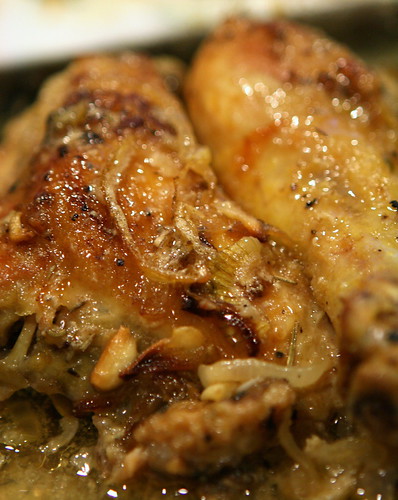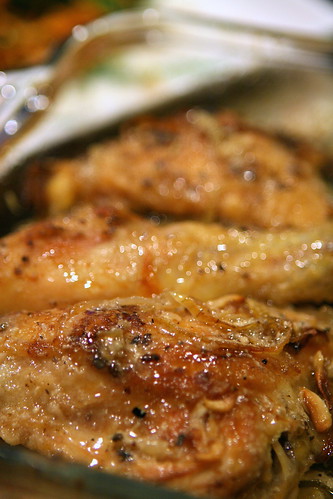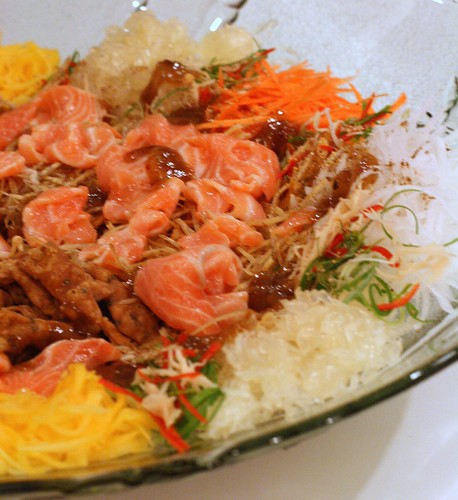
I think I better get this posted before the chap goh mei (15th day of the lunar new year when the new year celebration officially ends) so that you can also
'lou sang' without having to dig too deeply into your pocket!
Yee sang is a must-have CNY dish for us not only because it is sooo auspicious but it also tastes sooo good. The word
yee (fish) means abundance and surplus.
Sang means raw or lively. So
yee sang literally means “raw fish” and symbolizes abundance, prosperity and vitality. What more can you ask for?
This recipe was adapted from
Amy Beh's vegetarian dish featured in the Star newspaper many years ago. Since then, we have been doing it every year and it is a big hit with the whole family.
It requires a little more preparation but it is really well worth the effort.
No coloring, no preservatives, no msg and it is super delicious.
Traditionally, this was eaten on the seventh day of new year when the fishermen in Guangzhou celebrate their new year but nowadays, it is served all through the new year season.
Salmon Yee Sang~2 cups white radish, shredded and soaked in cold water
~2 cups carrot, shredded and soaked in cold water
~1 cup green mango, shredded
~50g spring onions, shredded and soaked in cold water
~1 red chili, shredded
~2 cups pickled papaya, shredded
~6 pickled leeks, shredded
~2 cups pomelo wedges, peeled and separate the sacs
~4 kaffir lime leaves, finely shredded
~20g young ginger, finely shredded
~1 pair yao char kwai, sliced thinly and deep-fried until crispy (I substituted
this with homemade deep fried crackers made of flour, nam yee, sesame seed, salt and water)
~1 cup sweet potato, finely shredded and deep fried
~1 cup yam (taro), finely shredded and deep fried (not in the original recipe but I added this cos I love yam and it has an auspicious sound
'wu tao' means 'good beginnings' )
~2 tablespoons toasted sesame seeds
~3 tablespoons roasted peanuts, pounded coarsely
~200g chilled sashimi-grade salmon, thinly sliced
~1/2 lime
Sauce
~100g plum sauce (original recipe - 300g)
~1 tbsp apricot jam
~3 tbsp lime juice
~1 tbsp honey (original recipe - 3T which I found too sweet)
~1 tbsp sesame paste
~1 tsp sesame oil
~1/2 tsp salt or to taste
~1/2 tsp Chinese five spice powder, put into a red packet
Combine the sauce ingredients in a small saucepan. Bring to a low simmering boil. Leave aside to cool completely before use.
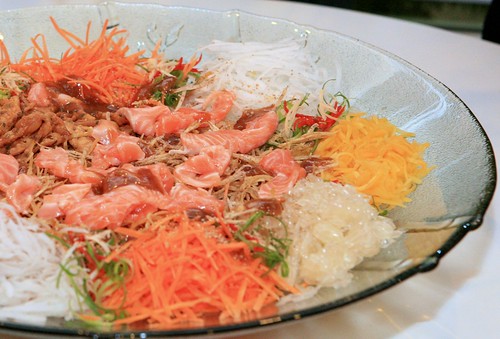
Drain the shredded carrot, radish and spring onion well. Arrange the shredded ingredients attractively on a big, round serving platter. We used a huge 50 cm serving glass plate for the 14 of us!
Squeeze half a lime over the fish slices and arrange them on top of the shredded ingredients.
 To serve, pour the sauce over the yee sang and sprinkle with the five-spice powder, the sesame seeds and roasted peanuts.
To serve, pour the sauce over the yee sang and sprinkle with the five-spice powder, the sesame seeds and roasted peanuts.
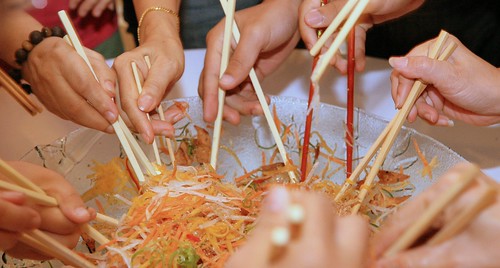 This is the fun part when we toss the salad together with chopsticks, wishing everyone good fortune, good health and greater success and lift everything higher and higher.
This is the fun part when we toss the salad together with chopsticks, wishing everyone good fortune, good health and greater success and lift everything higher and higher.
Jo
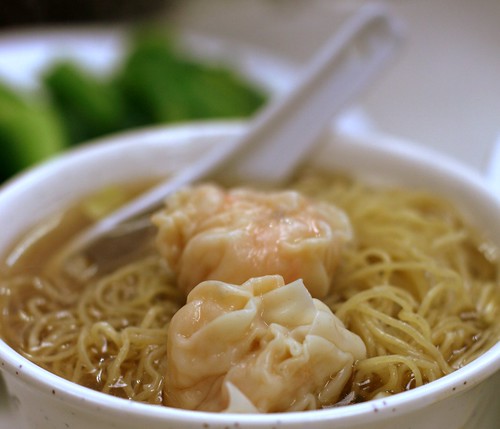 Wonton noodle.
Wonton noodle.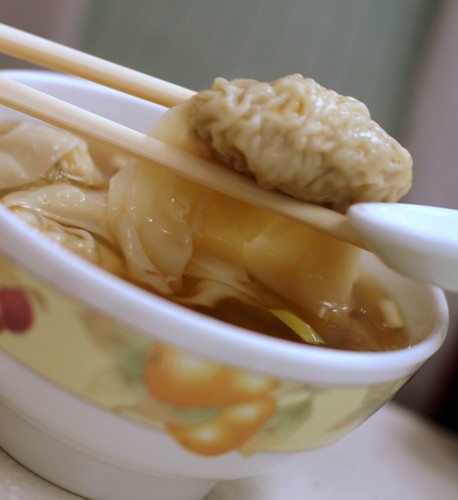 Mui and Yin had the 'shui jiao' dumpling noodles and they loved it too.
Mui and Yin had the 'shui jiao' dumpling noodles and they loved it too.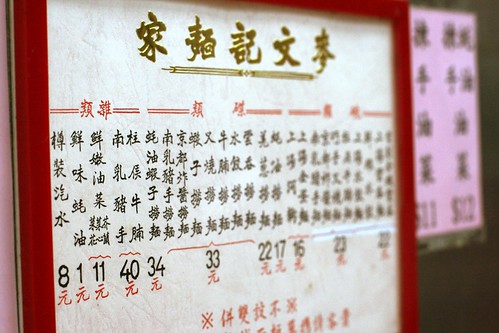 It is a no frills eatery, menu on the wall and a very limited choice of dishes.
It is a no frills eatery, menu on the wall and a very limited choice of dishes. 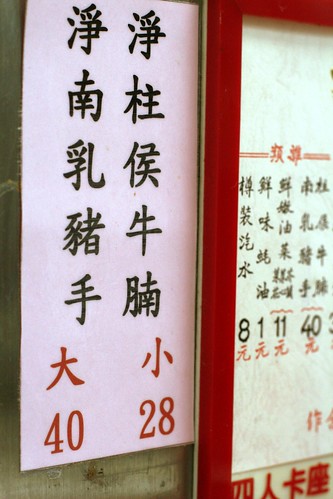
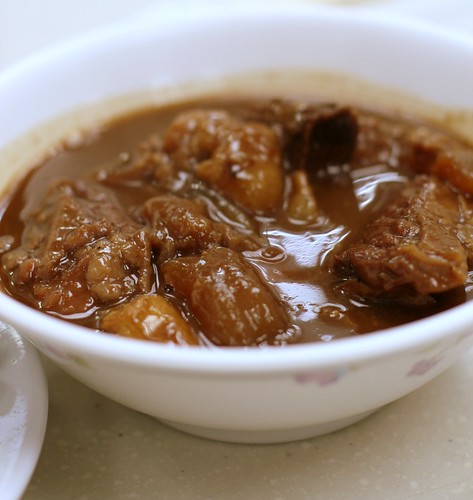 We loved this delicious braised beef brisket and tendons. The tendons were cooked to perfection and literally melts in the mouth. Our only complaint was that they don't serve rice with it. It would have been prefect with rice, lots and lots of rice to go with the incredible gravy.
We loved this delicious braised beef brisket and tendons. The tendons were cooked to perfection and literally melts in the mouth. Our only complaint was that they don't serve rice with it. It would have been prefect with rice, lots and lots of rice to go with the incredible gravy.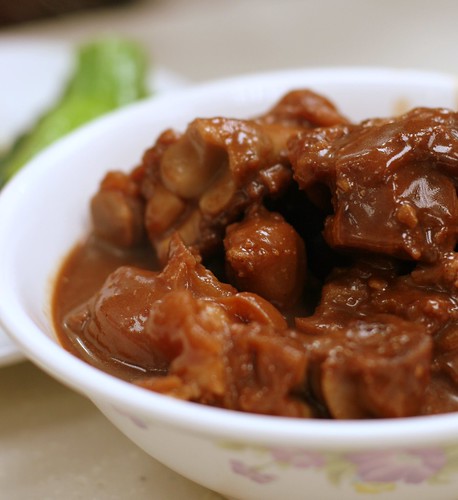 Braised pork leg with nam yee, fermented bean curd. Good too but a little too salty and we all preferred the beef tendon (a good source of collagen).
Braised pork leg with nam yee, fermented bean curd. Good too but a little too salty and we all preferred the beef tendon (a good source of collagen).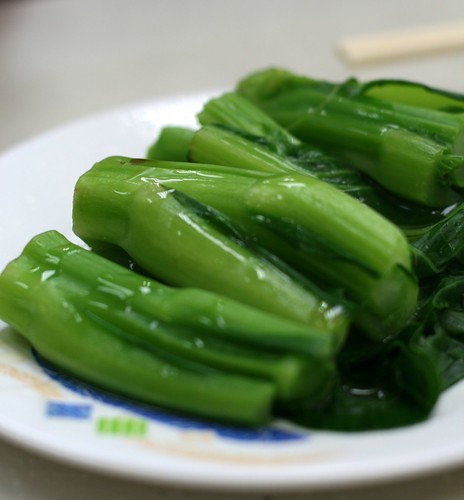 A simple blanched veggie.
A simple blanched veggie.
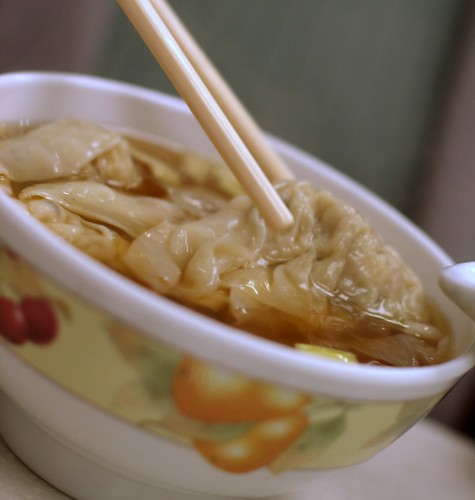
 Phew! Three cities in 6 days took a toll and I had to take a rest after the holiday. Slept for more than 14 hours straight to make up.
Phew! Three cities in 6 days took a toll and I had to take a rest after the holiday. Slept for more than 14 hours straight to make up. This trip was planned more than two months ago by Pit and her daughter, Yin. They arranged all the booking of air tickets and hotels through the internet. All Mui and myself had to do was pack our bags and be at the airport on time.
This trip was planned more than two months ago by Pit and her daughter, Yin. They arranged all the booking of air tickets and hotels through the internet. All Mui and myself had to do was pack our bags and be at the airport on time. Almost like a guided tour but better, as it was tailored to our own itinerary. This was my first flight with Air Asia and was very apprehensive as the airline has a reputation as the airline that not only enables everyone to fly but also to wait and wait and wait and…
Almost like a guided tour but better, as it was tailored to our own itinerary. This was my first flight with Air Asia and was very apprehensive as the airline has a reputation as the airline that not only enables everyone to fly but also to wait and wait and wait and… 
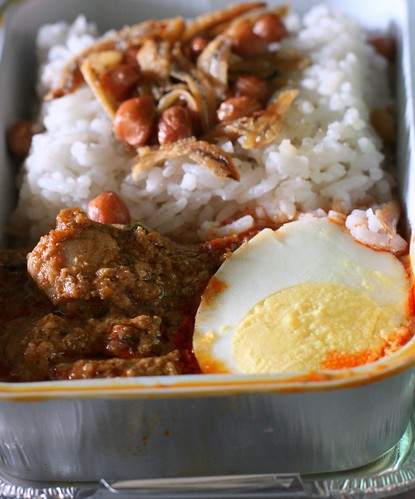 A nasi lemak dinner that cost Rm 8. Quite tasty though.
A nasi lemak dinner that cost Rm 8. Quite tasty though. Since we arrived early in Macau, we were able to catch the last Star ferry to Tsim Sha Tsui at 8.30pm (with a stretch of marathon running along the way!).
Since we arrived early in Macau, we were able to catch the last Star ferry to Tsim Sha Tsui at 8.30pm (with a stretch of marathon running along the way!). Arrived Kowloon just before 10pm and views of Hong Kong taken from where we disembarked at the Tsim sha Tsui 尖沙咀 terminal.
Arrived Kowloon just before 10pm and views of Hong Kong taken from where we disembarked at the Tsim sha Tsui 尖沙咀 terminal. Been to Hong Kong numerous times but the last time I stepped on Hong Kong soil was almost two years ago on a short transit stop from Chengdu, China. The sight of this city was still so breathtaking and for Yin, first time to Hong Kong, this must surely had been exhilarating.
Been to Hong Kong numerous times but the last time I stepped on Hong Kong soil was almost two years ago on a short transit stop from Chengdu, China. The sight of this city was still so breathtaking and for Yin, first time to Hong Kong, this must surely had been exhilarating.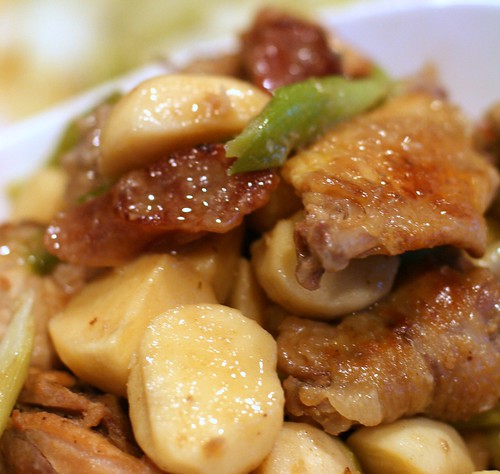
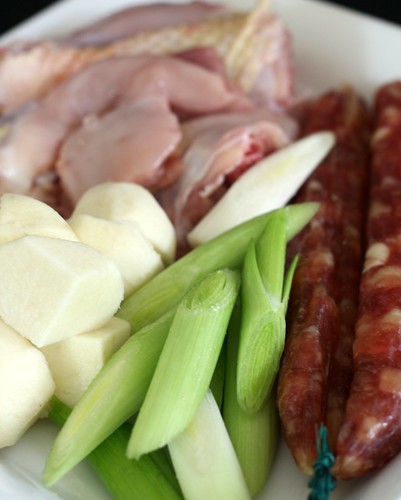 ~Season chicken pieces with some light soy sauce.
~Season chicken pieces with some light soy sauce. 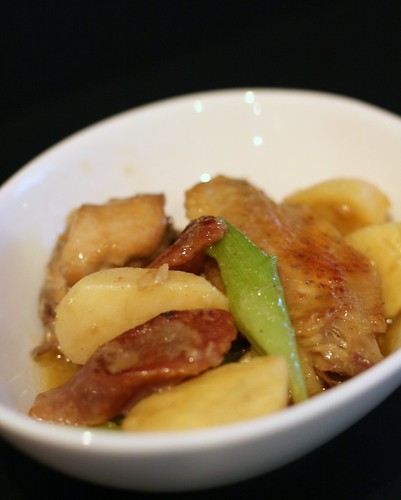 These are the last of the veggie and will have to wait another year for the next dish/date with these tubers!
These are the last of the veggie and will have to wait another year for the next dish/date with these tubers! 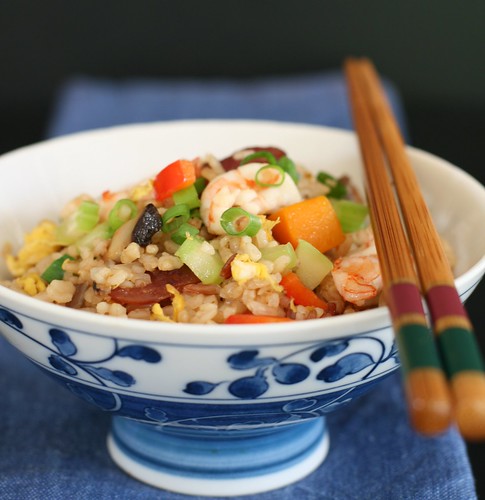 I love fried rice, to cook and to eat. Especially at this time when the fridge is packed with so many ingredients to choose from.
I love fried rice, to cook and to eat. Especially at this time when the fridge is packed with so many ingredients to choose from.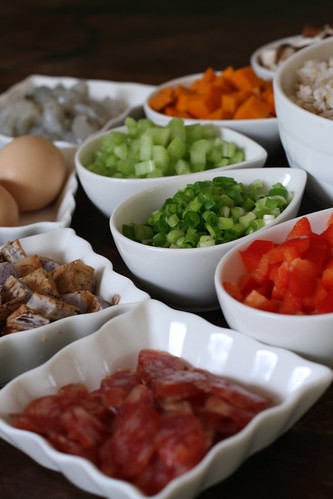



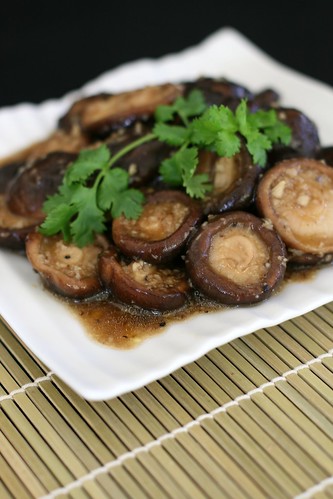

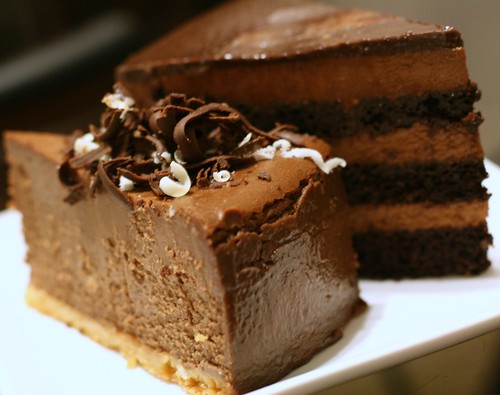
 I think I better get this posted before the chap goh mei (15th day of the lunar new year when the new year celebration officially ends) so that you can also 'lou sang' without having to dig too deeply into your pocket!
I think I better get this posted before the chap goh mei (15th day of the lunar new year when the new year celebration officially ends) so that you can also 'lou sang' without having to dig too deeply into your pocket! Drain the shredded carrot, radish and spring onion well. Arrange the shredded ingredients attractively on a big, round serving platter. We used a huge 50 cm serving glass plate for the 14 of us!
Drain the shredded carrot, radish and spring onion well. Arrange the shredded ingredients attractively on a big, round serving platter. We used a huge 50 cm serving glass plate for the 14 of us! To serve, pour the sauce over the yee sang and sprinkle with the five-spice powder, the sesame seeds and roasted peanuts.
To serve, pour the sauce over the yee sang and sprinkle with the five-spice powder, the sesame seeds and roasted peanuts. This is the fun part when we toss the salad together with chopsticks, wishing everyone good fortune, good health and greater success and lift everything higher and higher.
This is the fun part when we toss the salad together with chopsticks, wishing everyone good fortune, good health and greater success and lift everything higher and higher.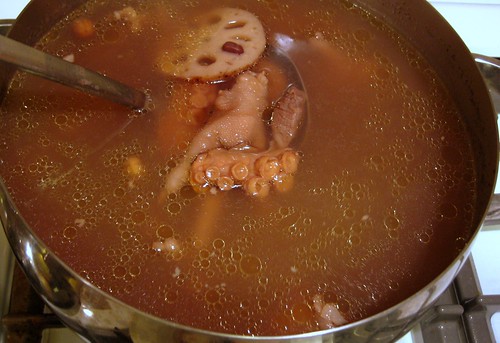
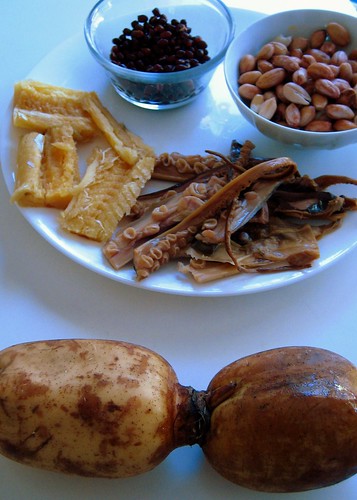
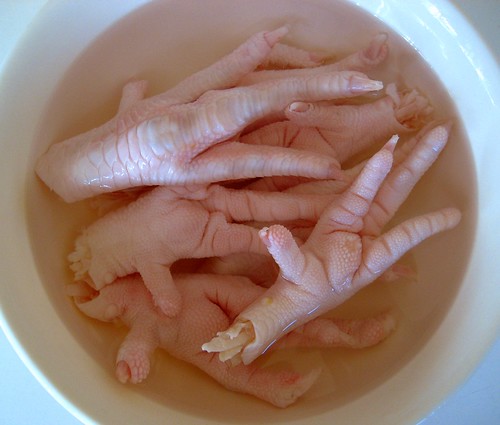
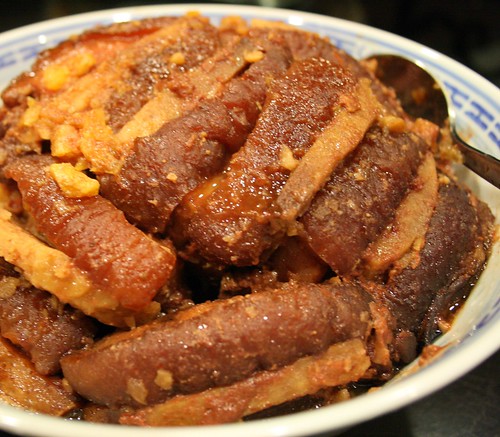
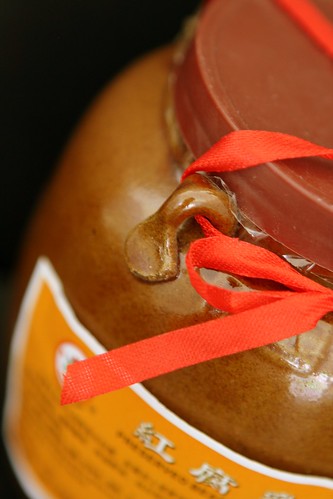 500 gm nam yee (red fermented bean curd) - get the one packed in this small brown jug
500 gm nam yee (red fermented bean curd) - get the one packed in this small brown jug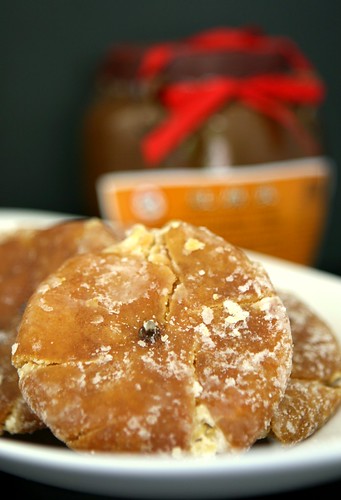

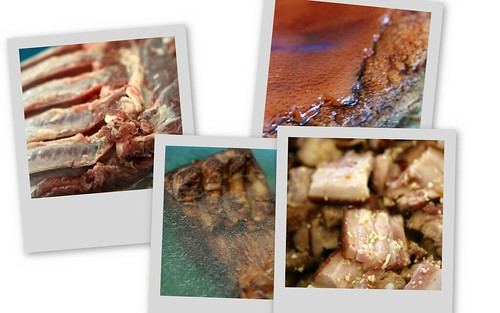 To prepare the pork:
To prepare the pork: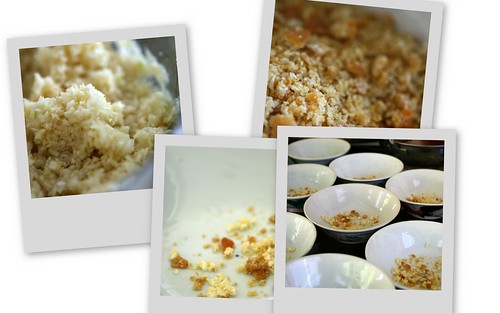
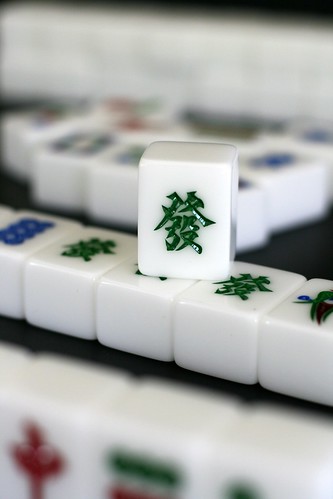 We will be taking leave from blogging for the cny period. Won't have much time to cook or to post.
We will be taking leave from blogging for the cny period. Won't have much time to cook or to post.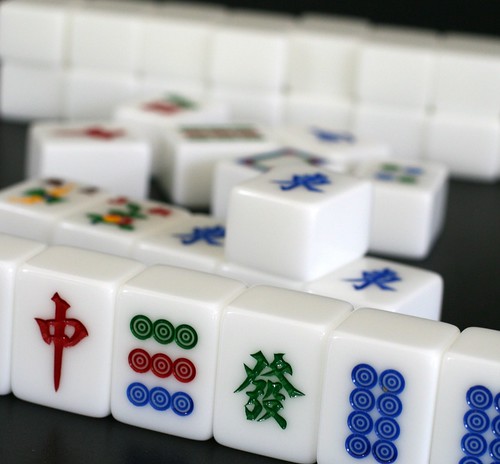

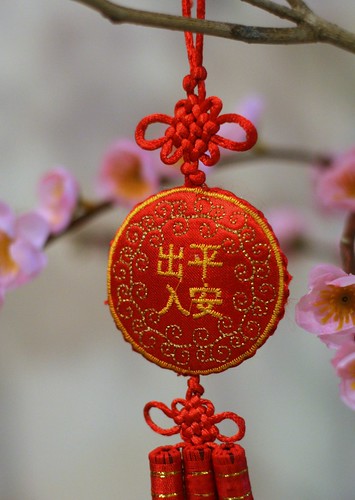 With these, let us wish you and your family loads of good health, wealth and harmony
With these, let us wish you and your family loads of good health, wealth and harmony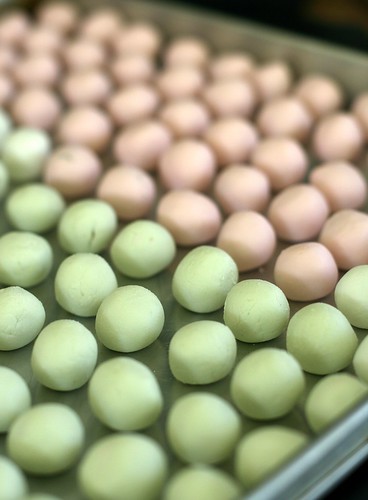
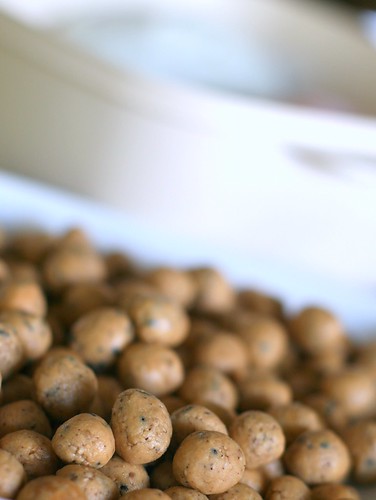 Filling:
Filling: Note: Tang yuan can be filled with tau sau (red bean paste), sesame seed paste or no filling at all. Soup can also be savoury with chicken stock.
Note: Tang yuan can be filled with tau sau (red bean paste), sesame seed paste or no filling at all. Soup can also be savoury with chicken stock.